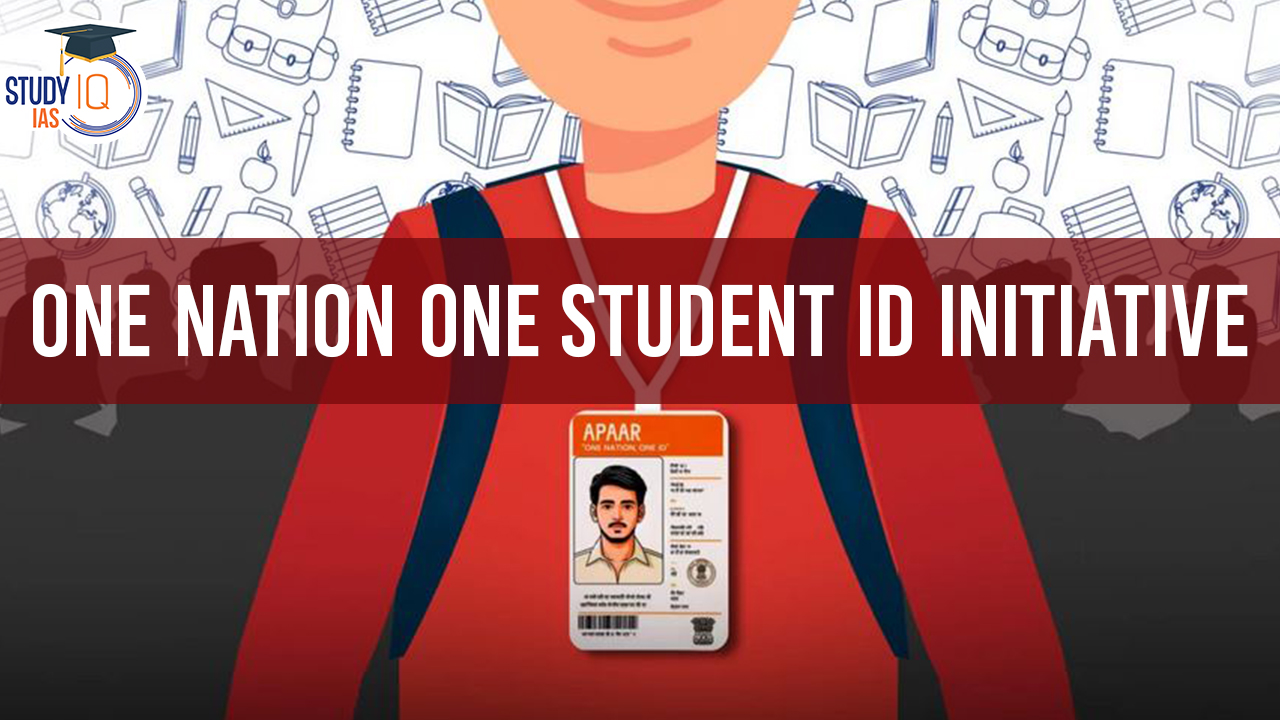Table of Contents
The ‘One Nation, One Student ID’ Initiative, also referred to as APAAR, is a unique identification system designed for all students across India. This initiative was introduced by the Ministry of Education and the Government of India as part of the National Education Policy 2020.
One Nation One Student ID Initiative
One Nation One Student ID Initiative or APAAR is a distinctive identification system implemented for all students in India, starting from their early childhood education. Under this system, each student is provided with a lifelong APAAR ID, which greatly simplifies the monitoring of their academic progress, spanning from pre-primary education to higher education.
Furthermore, APAAR serves as a bridge to Digilocker, an online digital repository, where students can securely preserve essential documents like examination results and report cards. This stored information can be conveniently accessed when needed for various purposes such as higher education applications or job placements.
We’re now on WhatsApp. Click to Join
How will APAAR work?
APAAR, which stands for Automated Permanent Academic Account Registry, is a unique identification system for students in India, designed to streamline the academic and administrative processes. Here’s how APAAR will work:
Unique Identification for Students
Every student, from the pre-primary level to higher education, will be assigned a unique APAAR ID. This ID serves as a digital identity for the student.
Digital Repository of Academic Records
The APAAR system will act as a digital repository that collects and stores a student’s academic achievements, exam results, learning outcomes, and co-curricular accomplishments. This comprehensive record includes both formal and informal learning experiences.
Authentication of Student Identity
To create an APAAR ID, a student’s identity will be authenticated through their Aadhaar ID or other officially recognized documents. This ensures that the student’s identity is verified and linked to their unique APAAR ID.
Verification for Instructors
Instructors working in Higher Education Institutions (HEIs) will also undergo a parallel verification process to ensure their credentials are legitimate.
Registration Using PAN Cards
Students and faculty members will have the option to use PAN cards for registration, offering an alternative to Aadhaar. This facilitates broader participation in the APAAR system.
International Student Registration
International students can complete their registration on APAAR using their passports, making it inclusive for students from various backgrounds.
Academic History in One Place
The central repository of APAAR allows students to maintain a comprehensive digital record of their academic journey throughout their lives. This includes transcripts, certificates, and other academic accomplishments.
Storage of Co-Curricular Achievements
APAAR goes beyond traditional academic records and also includes co-curricular achievements, such as rankings in Olympiads, specialized skill training, and extra-curricular accomplishments. This showcases the holistic development of students.
Streamlined Admission Process
When students transfer from one school or educational institution to another, the new institution can access the student’s entire academic history and achievements through their APAAR ID. This simplifies and streamlines the admission process.
Data-Driven Decision Making
APAAR provides valuable insights into student performance, learning trajectories, and areas that need improvement. Educational institutions can use this data to tailor their teaching methods and support services for individual students, leading to a more personalized education system.
Enhanced Accountability
APAAR can serve as a tool for increased accountability and transparency in the education sector. It makes it easier for authorities, educational boards, and institutions to track student progress, monitor performance, and assess the effectiveness of education policies.
| APAAR | Function | Rationale |
| What is APAAR? | – Unique student identification system for all of India | – Streamlined education processes |
| – Provides lifelong student ID | – Part of National Education Policy 2020 | |
| – Serves as a gateway to Digilocker | – Empowers state governments | |
| How does APAAR ID function? | – Assigns unique APAAR ID | – Combats fraud and duplicates |
| – Links to the Academic Bank Credit (ABC) | ||
| – Facilitates seamless data transfer between schools | ||
| – Allows storage of certificates and credits from various sources |
How to Get an APAAR ID?
| APAAR Registration Process | |
| Step 1: Enrollment Details | – Information Required: Name, Age, Date of Birth, Gender, and a Photograph. |
| – Verification: Provided information is verified using the student’s Aadhar number. | |
| Step 2: Aadhar Authentication | – Purpose: Aadhaar number is used solely for verification. |
| – Data Protection: No sharing of Aadhar data during the registration process. | |
| Step 3: Parental Consent for Minors | – Mandatory for Minors: Parental consent is required for minors to use their Aadhar number for authentication with UIDAI. |
| – Ensures Privacy: Protects the privacy and consent of minors in the registration process. | |
| Step 4: Voluntary Registration | – Registration Type: Registration for creating an APAAR ID is entirely voluntary. |
| – Not Mandatory: Students are not obligated to register for APAAR; it is an optional process. | |
Pros and Cons of APAAR
Pros of APAAR
- Streamlined Academic Records: APAAR centralizes a student’s academic history, making it easy to access and manage transcripts, certificates, and other academic achievements.
- Efficiency: The system simplifies administrative processes for educational institutions, reducing paperwork and manual record-keeping.
- Holistic Record Keeping: APAAR includes co-curricular achievements, allowing students to showcase their diverse talents and growth.
- Smooth Transfer Process: When students change schools or institutions, their academic records and achievements are readily available, simplifying the admission and transfer process.
- Data-Driven Decision Making: Educational institutions can use APAAR data to tailor their teaching methods and support services for individual students, leading to more personalized education.
- Enhanced Accountability: APAAR can be a tool for increased accountability and transparency in the education sector, helping authorities monitor student progress and assess education policies’ effectiveness.
- Access to Opportunities: Students can easily share their academic records with potential employers, higher education institutions, and scholarship providers, making it easier to access opportunities.
Cons of APAAR
- Data Privacy Concerns: Some students and parents may have concerns about data privacy, especially when using Aadhaar or other personal information for verification.
- Digital Divide: APAAR relies on digital technology, which may exclude students who do not have access to the internet or electronic devices, potentially creating a digital divide.
- Security Risks: Storing sensitive academic and personal data in a digital repository raises security concerns. There is a risk of data breaches and unauthorized access.
- Implementation Challenges: Implementing APAAR in all educational institutions and ensuring data accuracy can be a logistical challenge.
- Potential for Misuse: If not properly monitored, APAAR data could potentially be misused, leading to identity theft or other fraudulent activities.
- Dependence on Technology: Overreliance on digital systems may pose challenges when there are technical issues or disruptions.
- Consent and Choice: While registration is voluntary, the pressure to enroll in APAAR may lead to a lack of informed consent.
One Nation One Student ID Initiative UPSC
The ‘One Nation, One Student ID’ Initiative, also known as APAAR, is a unique student identification system introduced under the National Education Policy 2020 by the Ministry of Education in India. It assigns each student a lifelong APAAR ID, simplifying the tracking of academic records and achievements. Students’ data is authenticated through Aadhaar or other documents, and a parallel verification process is in place for instructors.
APAAR streamlines the admission process, provides valuable data for personalized education, and enhances accountability. However, it raises data privacy concerns, potentially excludes digitally disadvantaged students, and poses security and implementation challenges.


 List of Awards and Honours Received by N...
List of Awards and Honours Received by N...
 Employment Linked Scheme (ELS), Objectiv...
Employment Linked Scheme (ELS), Objectiv...
 List of GI Tag Products in India 2025, S...
List of GI Tag Products in India 2025, S...





















